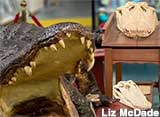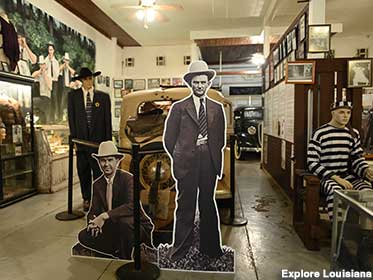
Three lawmen, one doomed prisoner, and a Death Car.
Bonnie and Clyde Ambush Museum
Gibsland, Louisiana
The 1930s outlaws with the most star power were Bonnie Parker and Clyde Barrow, the rogue Romeo and Juliet of Depression America. After a brief career of robbing gas stations and stealing cars, and as the leaders of a gang of notorious cop-killers, they were slaughtered by a posse of angry lawmen outside of Gibsland, Louisiana.
The Bonnie and Clyde Ambush Museum is the centerpiece of tiny Gibsland, housed in a building that used to be Ma Canfield's Cafe. Bonnie and Clyde stopped here on May 23, 1934, bought a fried baloney sandwich and BLT to go, then headed down the road in their soon-to-be "Death Car" -- a stolen V-8 Ford -- and got killed. According to one account, Bonnie died holding her half-eaten sandwich.
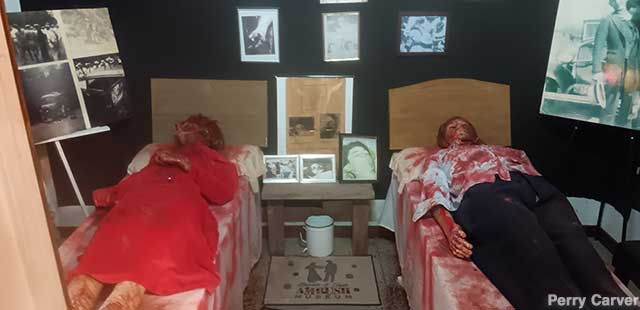
Replica morgue displays the bloody body-dummies of America's outlaw Romeo and Juliet.
The owner and public face of the museum is Perry Carver, a well-spoken authority on all things Bonnie and Clyde. He took over from the late L.J. "Boots" Hinton, son of one of Bonnie and Clyde's killers.
The museum opened in 2005, too late and too poor to get the real bullet-ridden Death Car (which in 1988 was purchased for a quarter-million dollars by a Nevada casino). During Boots' tenure the museum displayed the Death Car from the 1967 Bonnie and Clyde film, but it was eventually sold to the Alcatraz East museum in Tennessee ("It was a movie prop," Perry said, dismissively). Perry brought in a different Death Car, probably the one with the best pedigree of several fraudulent Death Cars, at least by Bonnie and Clyde Death Car standards. "It was shown as the real car for 55 years," Perry said, and it was such a good fake that it took a U.S. District judge to finally determine that it wasn't the original. It was also owned by a friend of Perry's family, so Perry got to hang out in it as a child in the 1960s. "I probably got more hours in the car than Clyde," Perry said.
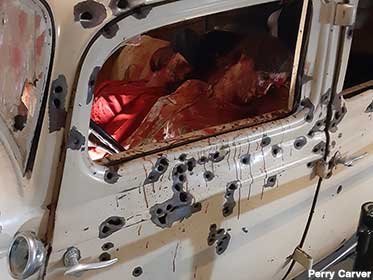
Can you count the bullet holes?
In the museum, a mural fills the wall next to the Death Car, recreating the last thing seen by Bonnie and Clyde: six rifle barrels aimed straight at them by six men. Perry has garnished the car with fake blood splatters and Bonnie and Clyde gore-soaked dummies. "Because it's not the real car, I can play with it," Perry said. "If it was the real car, I wouldn't touch it." That principled approach, said Perry, was not followed by the owners of the real Death Car, who had it gutted and rebuilt in 1987 before driving it from Disney World to Disneyland as a publicity stunt. "They screwed the real car up by doing that," Perry said, sadly.
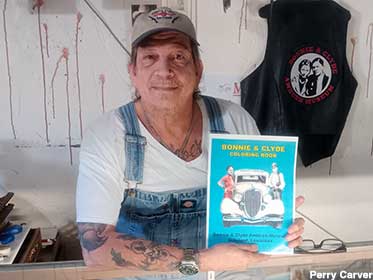
Museum owner Perry Carver with some gift shop souvenirs.
The Death Car, of course, had been screwed up before: first when it was riddled with 167 bullets, then when souvenir hunters (and the ambush squad) took everything in the car that wasn't nailed down, including parts of the car itself (Scavengers even tried to cut off Clyde's trigger finger -- much like the digit dismemberment of Pancho Villa). The relics were dispersed across the USA, but they are now, gradually, being pulled back into Gibsland by Perry.
The museum offers an ample display of vintage guns, which is expected: Bonnie and Clyde traveled with a well-stocked arsenal, including Bonnie's "cigar moll photo" six-shooter partly etched with her initials. The outlaw couple's everyday items, however, are the museum's most evocative mementoes. "I've got several of Bonnie and Clyde's hats," Perry told us. "I've got a sweater of hers that came out of the Death Car, and a manicure set that Bonnie had, and a fur coat. I've got Clyde's shoes; they were in the back seat" (Clyde had cut off two of his toes in prison, so he drove in his socks).
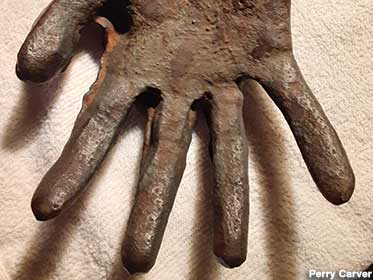
Clyde's itchy trigger finger in bronze.
The fact that the museum also owns Clyde's saxophone prompted an impassioned defense of Bonnie and Clyde from Perry, who described them as just young people who were dealt a bad hand. "People ask me, 'Why do you have this museum for these killers?'" said Perry. "They were not these two crazy killers!"
According to Perry, Bonnie and Clyde "weren't all innocent," but they also only killed out of fear or revenge, and most of the murders pinned on them were in fact committed by other members of their gang. "These two kids were scared, every day," Perry said. "If they were ruthless killers, they would not have been able to run for over two years. The public would not have helped them as long as they did."
And then help themselves to as many pieces of Bonnie and Clyde as they could grab.
One of the stranger relics in the museum is a metal facsimile of Clyde's hand. Unlike John Dillinger and Pretty Boy Floyd, casts of Bonnie and Clyde's faces weren't made after their deaths, but the local undertaker made a plaster cast of Clyde's right hand (including his un-amputated trigger finger). The reporter who photographed the corpses took the hand home, but his wife refused to have it in the house, so he gave it to his brother. "He had it bronzed and used it as a doorstop," Perry said. When his son was going through his father's possessions with Perry, they came across a small white box labeled Clyde's Hand. "'I forgot all about this,'" he told Perry. "'This thing used to scare me to death.'"
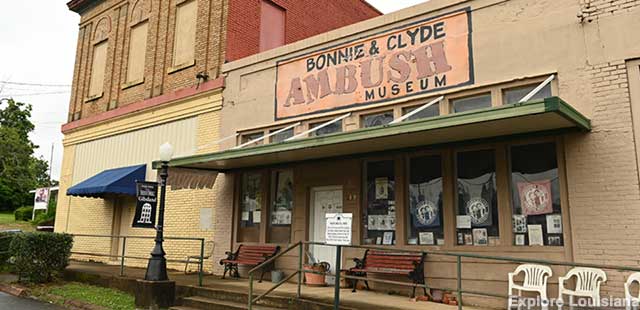
The Museum fills the former cafe where Bonnie and Clyde bought their last meal.
Tangental artifacts in the museum -- too many to count -- include a tire that Clyde stole and gave to an old man (who refused to use it, but who kept it as yet another memento), the table on which Bonnie and Clyde's bodies were examined by the coroner, and the public phone used by the deputies in Gibsland to tell the world that Bonnie and Clyde were dead.
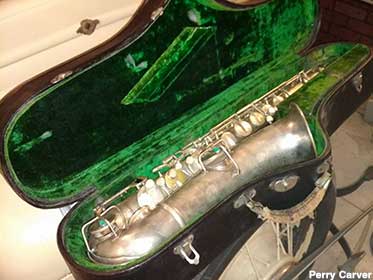
Fun fact: Clyde played the saxophone and guitar.
There's a head-in-a-hole photo op where visitors can pretend to be the famous outlaws, a dummy of Barrow gang member Ray Hamilton sitting in a replica electric chair (which in real life is where he ended up), and a gift shop packed with souvenirs including Bonnie and Clyde coloring books and snow globes.
Perry has built a simulated morgue in the museum, complete with bloody Bonnie and Clyde dummies -- a historical necessity, he explained. "I put that in because 20,000 people showed up the day they were killed to see their bodies." Replicas of Bonnie and Clyde's tombstones, sit side-by-side in an indoor, simulated graveyard. "They wanted to be buried together," Perry said, although they were instead interred several miles apart in separate cemeteries. "I've actually had people come in and ask, 'Are they really buried back there under that concrete?'"
After taking all of this in, visitors can walk through a doorway to the revived Ma Canfield's Cafe and order a fried baloney sandwich and BLT, just like the infamous doomed lovers.
Ten minutes south of the Ambush Museum, on a lonely stretch of road, travelers will find the stone monument that marks the Bonnie and Clyde death site. It was erected in 1972, and over the years it has been covered with graffiti, gouged with axes, and blasted with gunfire, to the point where its inscription is barely legible (It has even been yanked out of the ground a few times). Hearts and intertwined initials scrawled on the monument suggest that young couples make pilgrimages to the spot. The romantic vandalism seems appropriate. Bonnie and Clyde would have defaced monuments, too.
Perry said that he has a plan to replace the battered monument, but that the town hasn't yet agreed to his proposal. "I told them that if you give it to me," he said, "I'll help pay for the new one by bustin' up the old one and selling little pieces."





